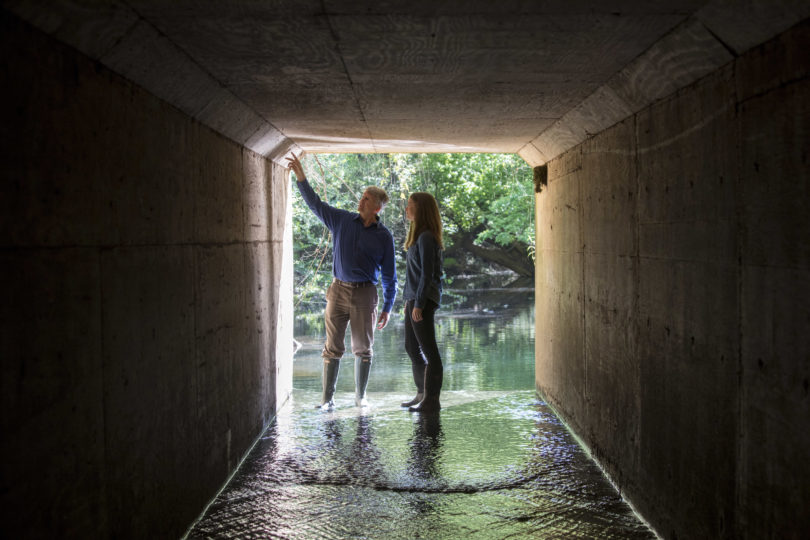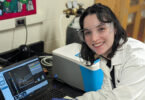Marshall Shepherd’s research has always been interdisciplinary, but working on a team funded by the President’s Interdisciplinary Seed Grant has made it even more so.
“The seed grant with colleagues like Brian Bledsoe has served as an accelerant for impactful collaborations and new research,” said Shepherd, a Georgia Athletic Association Distinguished Professor in the Franklin College of Arts and Sciences. “It is already bearing fruit with the Institute for Resilient Infrastructure Systems and our new collaboration with the Army Corps of Engineers, N-EWN. One of the most ‘out of the box’ journal articles that I have ever written came from these efforts.”
This kind of broadened perspective is a hallmark of the Presidential Interdisciplinary Seed Grant Program, designed to encourage interdisciplinary collaboration. The second round of grants was launched by President Jere Morehead in 2019 as part of the Great Commitments Initiative.
“The complex challenges facing our world require solutions that incorporate diverse perspectives,” said Morehead. “I am pleased that the seed grant program has succeeded in bringing together leading faculty from multiple disciplines to address these grand challenges while building the research enterprise of our university.”
Thinking outside the box
More than 70 faculty teams submitted research proposals targeting the following grand challenges: Healthier People, A More Secure Future, and Stronger Communities. The proposals were reviewed by a team of faculty and administrators led by Vice President for Public Service and Outreach Jennifer Frum and Vice President for Research David Lee. Seven teams were selected to receive awards from the $1 million made available.
“The collaborations formed as a result of the seed grant funding are enabling our faculty to look with even more depth into potential solutions for the critical issues facing our state,” Frum said. “That’s what we are meant to do as a land-grant and sea-grant institution—use our collective knowledge to improve the lives of all Georgians.”
The funded proposals, which span 15 UGA colleges, schools and other units, investigate aspects of human and animal health, communications and the environment.
Jeb Byers, a Meigs Distinguished Teaching Professor in the Odum School of Ecology, has pulled together a group from a variety of disciplines to explore the effects of parasites and diseases on fisheries. His team includes experts in marine microbial ecology, mathematics modeling, shellfish research, veterinary pathology, forestry, fisheries, environmental microbiology, population and community ecology, and population genetics.
“Each of these people brings a different perspective and different toolbox,” Byers said. “That’s been one of the most intellectually engaging parts of this project.”
Making progress during a pandemic
2020 was a difficult year, with the COVID-19 pandemic delaying or even halting research projects, but the teams worked hard to continue moving forward.
Rawad Saleh, an assistant professor in the College of Engineering, is leading a project focused on the environmental impacts of next-generation vehicle engine technologies. The team has performed experiments to explain combustion fundamentals and pollution formation in combustion, as well as large scale air-quality and climate modeling simulations. His team—which includes experts in engineering, air quality and climate, chemistry and geography—published their results in eight peer-reviewed journal articles fully or partially supported by the seed grant.
“One of the interesting synergies that resulted from our interactions is a future plan to study public health and climate impacts of wildfire emissions,” he said. “This will be in collaboration with other researchers at UGA and other institutions as well as the U.S. Forest Service Southern Research Station.”
Sun Joo “Grace” Ahn, an associate professor in the Grady College of Journalism and Mass Communication, is leading a team focused on boosting military readiness and retention by leveraging virtual reality and augmented reality technologies to improve family communication during deployments. Her team—which includes researchers in communications, engineering, human development and family science, and computational models—participated in UGA I-Corps last fall, spending eight weeks thinking about and gathering interview data on the technology readiness of their project for commercialization.
“This opportunity really allowed us to consider the practical implications of our research project,” Ahn said. “It was also encouraging to reconfirm the significance of our project through interviews. Military services members struggle immensely to communicate with their families during deployment, and existing platforms are extremely limited in their abilities to maintain family connection, particularly for younger children.”
For the team led by Brian Bledsoe, a Georgia Athletic Association Distinguished Professor in the College of Engineering, the seed grant has enabled several activities focused on promoting more widespread use of natural infrastructure around the country. In addition to Shepherd, who also directs UGA’s atmospheric sciences program, Bledsoe’s team includes experts in engineering, hydrology, environmental science, environmental economics, forestry, planning and environmental services, natural resources economics, anthropology, architecture, landscape architecture, ecology, water policy and working with local governments.
Seed grants spur more funding
When the first round of President’s Interdisciplinary Seed Grants was awarded in 2017, 12 faculty teams received funds totaling $1.37 million. The work enabled by those seed grants supported subsequent applications for external funding that brought nearly $13 million in new grants to UGA in just the first three years. That’s a minimum 10-to-1 return on investment, with the likelihood that additional funding based on the seed grants will be received.
The second-round seed grants are on track to be equally productive.
“We’re excited to see the cross-campus synergies resulting from these collaborations,” Lee said. “These were innovative proposals that promise important moments, have attracted strong external funding and helped to initiate new strategic directions for the university.”
For Bledsoe’s team, the seed grant contributed to the development of a $10 million proposal to the National Science Foundation to establish an Engineering Research Center, the creation of an ongoing collaboration with the U.S. Army Corps of Engineers’ Engineering with Nature program, and approximately $8 million in funding proposals that are currently under review.
Ahn’s team is applying for $2.5 million in funding at the Medical Technology Enterprise Consortium. Having an interdisciplinary team increases funding possibilities, according to Ahn.
“Because of the diverse range of expertise, we have been able to look at extramural funding opportunities in a much more flexible way than single-discipline research teams,” she said.








